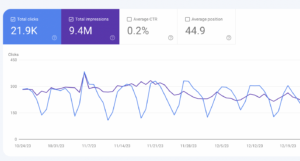In 2024, the term SEO is no stranger to anyone involved in online business or marketing. But how many of us are familiar with the term “Technical SEO?” This critical aspect of search engine optimization often goes unnoticed, yet it plays an instrumental role in ensuring a website’s optimal performance.
In this article, we peel back the layers of technical search engine optimization, exploring its significance and components, and share 10 best practices to keep your website in tip-top shape. Whether you’re a seasoned modern SEO expert or a beginner trying to navigate the complex waters of digital marketing, this guide offers valuable insights to enhance your SEO strategy. Let’s dive in!
What is Technical SEO?
Technical SEO refers to the optimization of your website’s infrastructure, ensuring it excels during the crawling and indexing stages by search engines. Its primary objective is to enhance the technical aspects of a website to amplify its organic rankings. Key components like site speed, mobile-friendliness, architecture, security, and the newly emphasized Core Web Vitals play crucial roles in this optimization process.
Core Web Vitals, introduced by Google, specifically measure aspects of web usability such as loading performance, interactivity, and visual stability (More on this below). In essence, technical SEO not only ensures your site is easily discoverable and interpretable by search engines but also prioritizes user experience and readability — both of which are crucial for boosting search rankings.
Why is Technical SEO Important for Every Business?
Technical SEO plays a pivotal role in the online visibility and success of any business, irrespective of its industry, size, or digital domain. From small startups to multinational corporations, from e-commerce platforms to informational websites, the significance of tech SEO cannot be overstated.
At its core, technical SEO focuses on optimizing the technical aspects of a website to enhance its search engine performance. This involves ensuring that search engine crawlers can efficiently crawl and index the website’s content, identifying and fixing technical issues that may hinder search engine visibility, and optimizing site speed and mobile-friendliness. While content and backlinks are crucial components of SEO, neglecting the technical aspects can severely undermine the effectiveness of any SEO strategy.
Impact on Search Rankings
One of the primary reasons why technical SEO is indispensable is its direct impact on search engine rankings. Search engines like Google continually update their algorithms to deliver the most relevant and user-friendly results to their users. These algorithms take into account various technical factors when determining the ranking of web pages. Websites that are well-optimized from a technical standpoint are more likely to rank higher in search engine results pages (SERPs), driving organic traffic and potential customers to the site.
User Experience
Moreover, technical SEO contributes to the overall user experience (UX) of a website. In today’s fast-paced digital landscape, users expect websites to load quickly and seamlessly across all devices. A website that is slow to load or difficult to navigate due to technical issues can frustrate visitors and lead them to abandon the site, resulting in lost opportunities for engagement and conversions. By optimizing technical elements such as site speed, mobile responsiveness, and structured data markup, businesses can create a more user-friendly website that keeps visitors engaged and encourages them to explore further.
Outrank Competitors
Furthermore, in an increasingly competitive online marketplace, staying ahead of the competition requires a comprehensive SEO strategy that includes a strong focus on technical optimization. Regardless of industry or organization size, businesses are vying for visibility in search engine results, aiming to capture the attention of potential customers. A website that is technically sound and optimized for search engines stands a better chance of outranking competitors and capturing valuable organic traffic.
Stay On Top of Trends
Additionally, the importance of technical SEO extends beyond traditional websites to other digital domains such as e-commerce platforms, mobile apps, and even voice search. With the proliferation of voice-activated devices and smart assistants, optimizing for voice search queries requires a deep understanding of technical SEO principles such as schema markup and natural language processing.
Technical SEO is indispensable for businesses across all industries, sizes, and digital domains. By focusing on optimizing the technical aspects of a website, businesses can improve search engine rankings, enhance the user experience, stay ahead of the competition, and adapt to emerging trends in the digital landscape. Neglecting tech SEO can result in missed opportunities for online visibility, customer engagement, and business growth.

How Does Technical SEO Differ From On-Page or Off-Page SEO?
SEO consists of three primary segments: Technical SEO, On-Page SEO, and Off-Page SEO. Each segment caters to distinct aspects of optimizing websites for search engines, and understanding their differences is crucial for holistic website optimization.
- Technical SEO: This focuses on the “behind-the-scenes” elements of a website. It ensures that search engines can efficiently crawl, index, and render a site. Key areas include site speed, mobile responsiveness, site structure, and XML sitemaps. Essentially, Technical SEO sets the foundation, ensuring the website is structured in a way that’s friendly to search engines.
- On-Page SEO: Centered on the visible content of individual web pages, On-Page SEO aims to ensure that each page is optimized for user experience and specific keywords. It deals with content quality, keyword research, meta tags, and internal linking. The goal here is to make sure that the content speaks effectively both to users and search engines.
- Off-Page SEO: As the name suggests, this focuses on external factors influencing a site’s search ranking. Predominantly concerned with building backlinks from other websites, Off-Page SEO also delves into brand mentions, social signals, and other external engagement metrics. It’s akin to the reputation management of a website in the broader digital ecosystem.
In essence, while Technical SEO optimizes the foundation and infrastructure, On-Page SEO refines the content and layout, and Off-Page SEO bolsters the website’s reputation and authority in the online realm.
Technical SEO Elements
Now that we have a basic understanding of what technical SEO entails, let’s delve into the key elements that form an effective technical SEO plan.
- Website Crawling: Website crawling is the primary stage where search engines discover your website. It’s the process where search engine robots, often called “spiders,” navigate through your site pages and posts. Ensuring that your website is easily crawlable is crucial for better indexing and higher SERP rankings.
- Indexing: After crawling comes the process of indexing, where the crawled data is cataloged and stored in a “searchable” format. A well-structured website increases the chances of more pages being indexed correctly.
- Page Speed: Google includes site speed as one of its ranking factors. A faster website not only improves user experience but also increases the chances of higher rankings. Optimize your site speed by compressing images, minifying CSS and JavaScript, and leveraging browser caching.
- Mobile-Friendliness: With mobile traffic surpassing desktop, it’s more important than ever that your site is mobile-friendly. This is also a Google ranking factor. A responsive design that adjusts to any screen size enhances the mobile user experience.
- XML Sitemap: An XML sitemap acts as a roadmap of your website that leads search engines to all your important pages. XML sitemaps can be useful for SEO as they allow Google to quickly find your essential website pages.
- Website Security: Having a secure website (HTTPS vs. HTTP) is another known Google ranking factor. HTTPS keeps the user data secure and also helps in building trust.
These elements are all interrelated, creating a holistic framework for technical SEO. Ensuring a website is crawlable and indexable lays the foundation for search engines to access and understand your site. Page load time, mobile-friendliness, and security all contribute to user experience, which search engines value highly. Finally, providing an XML sitemap further assists search engines in navigating your site, ensuring all your important pages are found and indexed.
What Makes a Good Technical SEO Plan?
A good technical SEO plan starts with a comprehensive technical SEO audit to identify any existing technical issues that could be affecting site performance and visibility. This could include issues related to site speed, mobile-friendliness, indexing, and security. Once identified, these issues should be prioritized based on their potential impact on your site’s performance and visibility.
The plan should also include:
- Regular monitoring of your site’s technical SEO health and performance using tools such as Google Search Console and Google Analytics. This will allow you to quickly identify and rectify any technical SEO issues that may arise.
- A focus on improving site speed, as this not only affects user experience but is also a known ranking factor for Google. Strategies could include optimizing images, minifying code, and leveraging browser caching.
- Ensuring your site is mobile-friendly, given the increasing proportion of web traffic coming from mobile devices.
- Implementing a secure (HTTPS) website. Not only is this a ranking factor for Google, but it also helps to build trust with your site visitors.
- Regular updates to your XML sitemap to ensure Google can easily find and index all of your important pages.
By focusing on these areas, you can develop a solid technical SEO strategy that will help improve your website’s performance, visibility, and user experience.
10 Technical SEO Best Practices for SEO Professionals
Technical SEO is similar to fine-tuning a car’s engine. A site may look spectacular on the outside, but if its underlying mechanisms aren’t running smoothly, it won’t get far in search engine rankings. SEO professionals, therefore, need to prioritize technical SEO to ensure their websites perform optimally. Here are 10 technical best practices every SEO expert should have in their toolkit:
1. Optimize Crawl Settings
- Robots.txt File: This file is essential for controlling which pages search engines can or cannot crawl. Ensure you’re not accidentally blocking essential pages.
- Crawl Budget: A site’s crawl budget is the number of pages search engines will crawl on a site during a given time. By optimizing this, you ensure critical pages aren’t overlooked.
2. HTTPS is a Must
Secure your website with SSL to shift from HTTP to HTTPS. Not only does this add a layer of security for your users, but search engines, particularly Google, also consider HTTPS as a ranking factor.
3. Page Speed Optimization
- Compress Images: Large image files can significantly slow down page load times. Use tools like TinyPNG or Compressor.io.
- Reduce Server Response Time: Invest in quality hosting and consider using a Content Delivery Network (CDN) to reduce latency.
4. Mobile-First Optimization
With a significant chunk of users accessing sites via mobile, it’s crucial to have a mobile-optimized, responsive design. Google’s Mobile-Friendly Test can offer insights into your site’s mobile optimization level.
5. Implement Structured Data
Using schema markup helps search engines better understand the context of your content. This can result in rich snippets in SERPs, potentially increasing click-through rates.
6. Address Duplicate Content
Duplicate content, or multiple pages with the same content, can dilute the value of your content in the eyes of search engines. Use canonical tags to specify which version of a page search engines should consider as the “primary” one.
7. Fix 404 Errors and Redirect Chains
- 404 Errors: These are dead ends for search engines and users. Identify each broken page and redirect it to another relevant page or remove links leading to it.
- Redirect Chains: Multiple redirects in a sequence can slow down page loading and confuse search crawlers. Simplify them to direct redirects whenever possible.
8. XML Sitemap Optimization
Keep your XML sitemap updated, ensuring it lists all vital pages of your site. Regularly submit the sitemap to search engines via tools like Google Search Console to help with search engine indexing.
9. International SEO for Multilingual Sites
If your site caters to multiple regions or languages, use hreflang tags. These inform search engines about the language and geographic targeting of a page, ensuring the right audience sees the appropriate content version.
10. Use Meta Tags
It’s best practice to ensure pages on your site have meta descriptions and meta title tags. This gives Google and other search engines context on what each page is about. Try to utilize the page’s target keyword in the title tag and meta description as well.

Core Web Vitals and Technical SEO
Core Web Vitals have emerged as a crucial aspect of Technical SEO, given their emphasis by Google as essential metrics for evaluating a website’s user experience. These vitals are a subset of factors that are part of Google’s page experience score, designed to provide quantifiable data about users’ experiences on a web page. Let’s delve deeper into their connection with Technical SEO.
Core Web Vitals are composed of three specific metrics:
- Largest Contentful Paint (LCP): Measures the loading performance of a page. A good LCP score indicates that the page’s main content loads quickly, ideally within 2.5 seconds of landing on a page.
- First Input Delay (FID): Quantifies interactivity. It evaluates the time it takes for a page to become interactive, with an ideal time being less than 100 milliseconds.
- Cumulative Layout Shift (CLS): Assesses the visual stability of a page. This metric is concerned with unexpected layout shifts that can be frustrating for users. A good CLS score is less than 0.1.
How Do the Core Web Vitals Tie Into Technical SEO?
Technical SEO is all about optimizing the structure and infrastructure of a website to ensure it’s crawlable, indexable, and offers an excellent user experience. Core Web Vitals perfectly align with these goals, focusing explicitly on user experience metrics.
- Website Performance: Technical SEO practices like optimizing images, leveraging browser caching, and minimizing code can directly improve LCP scores by ensuring content loads quickly.
- JavaScript Optimization: Properly optimizing and deferring non-essential JavaScript can enhance FID scores, as the browser can rapidly respond to user interactions without being bogged down by unnecessary scripts.
- Stable Design Elements: Ensuring design elements have set dimensions and utilizing techniques like “lazy loading” can prevent unexpected layout shifts, leading to better CLS scores.
Google has made it clear that Core Web Vitals are a ranking factor. This means websites that do not meet the expected benchmarks may experience a decline in organic visibility. Given the close alignment of Core Web Vitals with Technical SEO, professionals in the SEO realm must integrate these metrics into their optimization strategies. By doing so, they’ll not only appease search engines but also offer users a seamless, fast, and efficient browsing experience.
How to Learn Technical SEO Skills
Learning technical SEO skills is essential for anyone looking to optimize websites effectively and improve their search engine rankings. Here are several strategies to help you acquire and enhance your technical SEO skills:
- Online Courses and Tutorials: There are numerous online courses and tutorials available that cover various aspects of technical SEO. Platforms like Coursera, Udemy, and LinkedIn Learning offer courses taught by industry experts that cover topics such as website architecture, HTML, JavaScript, and structured data markup. These courses often include practical exercises and real-world examples to help you apply what you’ve learned.
- SEO Blogs and Websites: Stay updated with the latest trends and best practices in technical SEO by following reputable SEO blogs and websites. Websites like Moz, Search Engine Journal, Markitors, and Search Engine Land regularly publish informative articles, guides, and case studies on technical SEO topics. Reading these resources can help you gain valuable insights and stay abreast of industry developments.
- Google’s Documentation and Guidelines: Google provides extensive documentation and guidelines on technical aspects of SEO through resources such as the Google Webmasters Central Blog, Google Search Central, and the Google Search Console Help Center. Familiarize yourself with Google’s recommendations for creating search engine-friendly websites, resolving technical issues, and optimizing for mobile and speed.
- Hands-On Practice: Put your technical SEO skills into practice by working on real-world projects. Create your website or volunteer to help optimize websites for friends, family, or nonprofit organizations. Experiment with implementing technical SEO techniques such as optimizing meta tags, improving site speed, and resolving crawl errors. Hands-on experience will reinforce your learning and deepen your understanding of technical SEO principles.
- Join SEO Communities and Forums: Engage with fellow SEO professionals and enthusiasts in online communities and forums dedicated to SEO. Platforms like Reddit (e.g., r/SEO), SEO forums like WebmasterWorld and SEO Chat, and professional networking sites like LinkedIn have active communities where you can ask questions, share insights, and learn from others’ experiences in the field of technical SEO.
- Attend Workshops and Conferences: Attend workshops, webinars, and conferences focused on SEO to learn from industry experts and network with peers. Events like BrightonSEO, SMX (Search Marketing Expo), and Pubcon feature sessions specifically dedicated to technical SEO topics. Take advantage of these opportunities to gain practical knowledge, learn advanced techniques, and connect with professionals in the field.
- Experiment and Analyze: Continuously experiment with different technical SEO strategies and monitor their impact on search engine rankings and website performance. Use tools like Google Analytics, Google Search Console, and third-party SEO software to track changes in organic traffic, keyword rankings, and user engagement metrics. Analyze the results of your experiments to identify what works best for your website and refine your technical SEO approach accordingly.
By combining these strategies and resources, you can develop and enhance your technical SEO skills, positioning yourself as a knowledgeable and proficient practitioner in the field of search engine optimization.
Technical SEO Tools to Use
When delving into the realm of technical SEO, having the right tools at your disposal can make a significant difference in optimizing your website effectively. Here are some essential technical SEO tools that can help streamline the optimization process:
- Google Search Console: This free tool provided by Google offers invaluable insights into how your website is performing in search results. It provides data on indexing status, search queries, click-through rates, and more. Google Search Console also alerts you to any technical issues that may affect your site’s visibility in search results, such as crawling errors, mobile usability issues, and security issues.
- Google PageSpeed Insights: Site speed is a crucial factor in both user experience and search engine rankings. Google PageSpeed Insights analyzes the speed of your website on both desktop and mobile devices and provides suggestions for improving performance. It evaluates various metrics, such as First Contentful Paint (FCP) and Largest Contentful Paint (LCP), to help you identify areas for optimization.
- SEMrush: SEMrush is a comprehensive SEO tool that offers a wide range of features, including technical SEO auditing. It can crawl your website to identify technical issues such as broken links, duplicate content, and missing meta tags. SEMrush also provides competitive analysis, keyword research, and backlink analysis tools to help you optimize your website effectively.
- Moz Pro: Moz Pro is another all-in-one SEO tool that includes features for technical SEO auditing. It can crawl your website to identify issues such as crawl errors, duplicate content, and missing meta tags. Moz Pro also offers keyword research, rank tracking, and backlink analysis tools to help you improve your website’s search engine rankings.
- Screaming Frog SEO Spider: This desktop-based tool is widely used for technical SEO auditing. It crawls your website and provides detailed insights into various technical aspects, including broken links, duplicate content, missing meta tags, and server errors. Screaming Frog SEO Spider is particularly useful for larger websites with extensive content and complex structures.
- Ahrefs: Ahrefs is a powerful SEO tool that offers features for technical SEO analysis, including site auditing. It can crawl your website to identify technical issues such as broken links, redirect chains, and HTTP status code errors. Ahrefs also provides comprehensive backlink analysis, keyword research, and competitive analysis tools to help you improve your website’s SEO performance.
These are just a few examples of the many technical SEO tools available to help you optimize your website effectively. Depending on your specific needs and budget, you may choose to use one or more of these tools to ensure that your website is technically sound and optimized for search engines.
Get a free SEO site audit from Markitors!
Speak to Search Engines with Technical SEO
Technical SEO stands as the silent, foundational powerhouse behind a website’s success in the vast digital arena. By implementing the nine best practices outlined, you’re not only laying a strong groundwork for search engine visibility but also enhancing the overall user experience. Remember, in the world of SEO, a robust technical foundation can elevate all your other efforts, from content creation to link building.
If you’re keen on optimizing your site’s technical backbone and leading the digital race, don’t navigate these complexities alone. Reach out to the experts at Markitors — we’re here to guide, assist, and ensure your website is primed for success. Contact us today!







